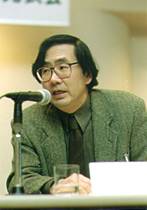

 |
 |
|
|
|
||||||||||||||||||||
Tatehata Akira |
|
 How will you decide on which artists to include? Tatehata: We will go directly to the different regions of the world and observe the art there with our own eyes, picking out the most outstanding artists. In your opinion, what is the significance of presenting a triennial exhibition in Yokohama at the present time? Tatehata: Japan has sent artists to participate in many international exhibitions in the past, and they have been well received. Now it is time to establish our own place for transmitting a message to the world, a place for communication between artists, and a place for communication between Japan and other regions. A large-scale international exhibition of this kind can exert a strong centripetal force and bring together many kinds of information in a concentrated form. We can expect it to energize the Japanese art scene, and it will lead to interchanges with other countries that will also affect the international art world. Through this exhibition, we can send an artistic message out to the world from Japan rather than simply using foreign art. This is the significance of having this exhibition here. As international exhibitions are held in major cities throughout the world, including Asia, I believe Japan has the same responsibility as other nations to share information and broadcast it to the international art scene. What are your impressions of Yokohama as an exhibition site? Tatehata: The character of Yokohama as a port city coincides with the image of the triennial as an event that is open to the world, receptive to information and a transmitter of information. Yokohama is a good place for this event because of its history and its image of openness. This is what makes it such an appropriate site for an international exhibition. How will Yokohama 2001 influence the world art scene or that of Japan? Tatehata: With an exhibition of this size you have certain advantages that come from scale. It should cause a sensation in Yokohama. Even people who ordinarily have little contact with contemporary art will be attracted by the excitement and the festive atmosphere. That is what we hope. Is there a division of labor among the four artistic directors? Tatehata: There is no clear division of labor between us. Each director has his own standards for evaluating contemporary art, so the artists will most likely be selected according to a variety of standards. The result should be an effective summing up of the current state of contemporary art. With four artistic directors, it will naturally be easier for us to grasp the overall outlines of today's art. What are you most looking forward to? And what do you think will be most difficult? Tatehata: What I look forward to the most is conferring with the artists about making new work for the show and being present while they are creating new forms of expression. However, I think there will be plenty of difficulty in setting up the actual exhibits. |
|